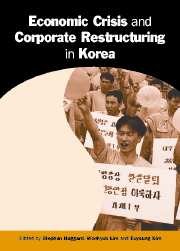Book contents
- Frontmatter
- Contents
- List of Figures
- List of Tables
- Preface and Acknowledgements
- Contributors
- A Note on Usage
- Abbreviations
- 1 Introduction: The Political Economy of Corporate Restructuring
- Part I The Politics and Economics of the Chaebol Problem
- Part II The Political Economy of Crisis Management
- Part III Reform and Restructuring
- 9 The Corporate Bankruptcy System and the Economic Crisis
- 10 Foreign Direct Investment and Corporate Restructuring after the Crisis
- 11 Competition Law and Policy
- 12 Reform of Corporate Governance
- 13 Conclusion: Whither the Chaebol?
- Index
13 - Conclusion: Whither the Chaebol?
Published online by Cambridge University Press: 05 July 2014
- Frontmatter
- Contents
- List of Figures
- List of Tables
- Preface and Acknowledgements
- Contributors
- A Note on Usage
- Abbreviations
- 1 Introduction: The Political Economy of Corporate Restructuring
- Part I The Politics and Economics of the Chaebol Problem
- Part II The Political Economy of Crisis Management
- Part III Reform and Restructuring
- 9 The Corporate Bankruptcy System and the Economic Crisis
- 10 Foreign Direct Investment and Corporate Restructuring after the Crisis
- 11 Competition Law and Policy
- 12 Reform of Corporate Governance
- 13 Conclusion: Whither the Chaebol?
- Index
Summary
This volume has shown that the chaebol as a corporate form cannot be divorced from a broader context that includes politics, policy and regulation, and a rapidly changing financial system. We summarize our findings by posing two questions of this complex of institutional relationships. The first is a balance sheet: how much change has occurred in Korea's system of corporate governance, broadly conceived, and what is the likely direction of change in the future? Is Korea moving toward a new model of business-government relations and corporate governance as a result of the crisis? Or are the chaebol form and the institutions that have supported it likely to persist?
The second question centers on the implications of such organizational changes for future economic performance. The chaebol were the main private agents of Korea's rapid growth in the three decades prior to the crisis of 1997-98. What does their transformation portend for the Korean economy? Is such change desirable, or neutral, or does it reflect a preoccupation with foreign models of corporate governance and an underestimation of indigenous organizational strengths?
To construct our balance sheet, we summarize the evidence presented in this volume in four broad areas: the political economy of business–government relations; reforms of the government–bank–chaebol relationship and the financial system; efforts to introduce competitive forces that would provide external discipline on the chaebol; and more direct efforts to change the corporate governance and internal organization of these firms.
- Type
- Chapter
- Information
- Economic Crisis and Corporate Restructuring in KoreaReforming the Chaebol, pp. 307 - 336Publisher: Cambridge University PressPrint publication year: 2003
- 3
- Cited by



